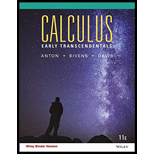
Use the Divergence Theorem to find the flux of F across the surface
Want to see the full answer?
Check out a sample textbook solution
Chapter 15 Solutions
CALCULUS EARLY TRANSCENDENTALS W/ WILE
Additional Math Textbook Solutions
Calculus, Single Variable: Early Transcendentals (3rd Edition)
Precalculus: Mathematics for Calculus - 6th Edition
Precalculus Enhanced with Graphing Utilities
Precalculus (10th Edition)
Calculus: Early Transcendentals (2nd Edition)
Glencoe Math Accelerated, Student Edition
- Find a vector function, r(t), that represents the curve of intersection of the two surfaces. The cylinder x² + y² = 49 and the surface z = xy r(t) = Xarrow_forwardVector F is mathematically defined as F = M x N, where M = p 2p² cos + 2p2 sind while N is a vector normal to the surface S. Determine F as well as the area of the plane perpendicular to F if surface S = 2xy + 3z.arrow_forwardHandwrittenarrow_forward
- Let F = -9zi+ (xe"z – 2xe*)}+ 12 k. Find f, F•JÃ, and let S be the portion of the plane 2x + 3z = 6 that lies in the first octant such that 0 < y< 4 (see figure to the right), oriented upward. Can Stokes' Theorem be used to find the flux of F through S? Clearly answer yes or no, and then briefly explain your answer.arrow_forwardFind the flux of F=z2kF=z2k upward through the part of the sphere x2+y2+z2=a2x2+y2+z2=a2 in the first octant of 3-space.arrow_forwardthe vector function r ( t ) = ⟨ 6 cos ( t ) , 3 − 3 sin ( t ) , 2 + 3 sin ( t ) ⟩ 1.Find the equation of the line tangent to the space curve at ( 0 , 2 , 3 ) 2.Find all the points where the space curve intersects the plane z=7.arrow_forward
- Determine the flux of F(x, y, z) = < −x2 + x, y, 8x3 − z + 9 > across the surface with an upward orientation. Let the surface be the portion of the paraboloid z = 9 − 4x2 −4y2 on the first octant above the plane z = 1.arrow_forwardConsider the space curve represented by the intersection of the surfaces. Represent the curve by a vector-valued function r(t) using the given parameter. r(t) = Surfaces z = x² + 2y², x+y=0 Parameter x = tarrow_forwardQ2/ Find T, N, and k for the space curve r(t) = (3 sin t)i +(3cos t)j + 4tkarrow_forward
 Algebra and Trigonometry (MindTap Course List)AlgebraISBN:9781305071742Author:James Stewart, Lothar Redlin, Saleem WatsonPublisher:Cengage Learning
Algebra and Trigonometry (MindTap Course List)AlgebraISBN:9781305071742Author:James Stewart, Lothar Redlin, Saleem WatsonPublisher:Cengage Learning
